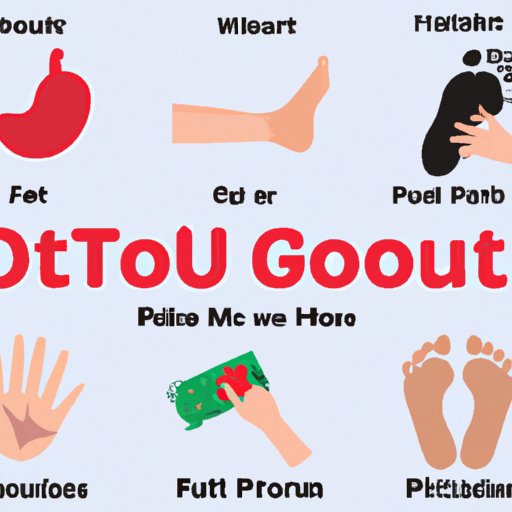Introduction
Gout is a type of arthritis caused by high levels of uric acid in the blood. It causes severe swelling, stiffness, and pain in the joints, usually in the big toe. While there is no cure for gout, there are dietary changes that can help relieve the symptoms.

Foods to Avoid When You Have Gout
Certain foods can worsen gout symptoms, so it’s important to be aware of what to avoid eating when you have gout.
High-Purine Foods
High purine foods should be avoided if you are trying to manage gout. Purines are compounds found in certain foods that break down into uric acid in the body. High-purine foods include red meat, organ meats, game meats, fish, shellfish, and poultry. According to the American College of Rheumatology, “Eliminating or reducing intake of these foods is recommended.”
Alcohol
Alcohol consumption can also trigger gout flares. A study published in the Journal of Rheumatology found that beer was the most common beverage associated with gout attacks, although all types of alcohol can increase the risk.
Sugary Foods
Sugary foods and drinks can also aggravate gout symptoms. A study published in the British Medical Journal found that people who consumed the most sugar had a higher risk of developing gout than those who consumed the least amount of sugar. Therefore, limiting your intake of sugary foods and beverages is recommended.
Healthy Eating Tips for Managing Gout
Making healthy lifestyle changes can help reduce your risk of gout flares. Here are some tips to keep in mind when managing gout with diet:
Eat a Balanced Diet
A balanced diet is key to managing gout symptoms. Aim to eat a variety of healthy foods from all the food groups, including whole grains, fruits, vegetables, lean proteins, and healthy fats. This will help ensure you get all the essential nutrients your body needs.
Increase Fiber Intake
Fiber has been shown to reduce inflammation and lower uric acid levels. Aim to consume at least 25 to 30 grams of fiber per day from foods like oats, legumes, fruits, and vegetables.
Limit Sodium Intake
Excess sodium can increase uric acid levels in the body, so it’s important to watch your sodium intake. The American Heart Association recommends consuming no more than 2,300 milligrams of sodium per day.
Drink Plenty of Water
Staying hydrated is important for overall health, and it can also help reduce gout symptoms. Drinking plenty of water throughout the day can help flush out the excess uric acid in your body.

The Best Fruits and Vegetables for Gout
Fruits and vegetables are packed with vitamins and minerals and are generally safe for people with gout. Here are some of the best fruits and vegetables for gout sufferers:
Low-Purine Fruits
Most fruits are low in purines, making them a safe choice for gout sufferers. Some examples of low-purine fruits include apples, bananas, oranges, grapefruits, pears, and berries.
Low-Purine Vegetables
Vegetables are also generally safe for gout sufferers. Low-purine vegetables include leafy greens, bell peppers, squash, carrots, potatoes, and tomatoes.
Low-Purine Protein Sources for Gout Sufferers
When choosing protein sources, look for low-purine options. Here are some of the best protein sources for people with gout:
Nuts and Seeds
Nuts and seeds are excellent sources of protein and are low in purines. Some examples include almonds, walnuts, sunflower seeds, pumpkin seeds, and flaxseeds.
Dairy Products
Dairy products are also low in purines and provide important nutrients like calcium and vitamin D. Choose low-fat dairy products like skim milk, yogurt, and cheese.
Beans and Lentils
Beans and lentils are good sources of plant-based protein and are also low in purines. Examples include black beans, chickpeas, kidney beans, and split peas.
Recipes for Low-Purine Gout-Friendly Meals
Following a gout-friendly diet doesn’t mean you have to sacrifice flavor. Here are some delicious recipes for breakfast, lunch, and dinner:
Breakfast Ideas
Overnight oats with blueberries and almond butter
Whole wheat toast with avocado and eggs
Smoothie bowl with banana, spinach, and chia seeds
Lunch Options
Grilled salmon with roasted sweet potatoes and asparagus
Quinoa salad with tomatoes, cucumbers, and feta cheese
Turkey wrap with lettuce, tomato, and hummus
Dinner Suggestions
Veggie stir fry with tofu, bell peppers, and mushrooms
Baked cod with roasted Brussels sprouts and quinoa
Roasted chicken with cauliflower and green beans
Conclusion
Gout is a type of arthritis that can cause pain and swelling in the joints. Making dietary changes can help reduce gout symptoms. Avoid high-purine foods, alcohol, and sugary foods, and focus on eating a balanced diet with plenty of fruits, vegetables, low-purine proteins, and healthy fats. With the right meal plan, you can manage your gout symptoms and enjoy flavorful, nutritious meals.
(Note: Is this article not meeting your expectations? Do you have knowledge or insights to share? Unlock new opportunities and expand your reach by joining our authors team. Click Registration to join us and share your expertise with our readers.)
